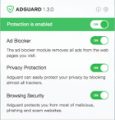What is SearchKeyWords
SearchKeyWords is a malicious application that belongs to the Adware category. Adware can make big problem to your Mac. Adware sometimes named ‘ad-supported’ software is a type of malicious software which displays a huge count of adverts in form of pop-up windows, discounting deals, promos or even fake alerts on the web browser. Adware software can seriously affect your privacy, your computer’s performance and security.
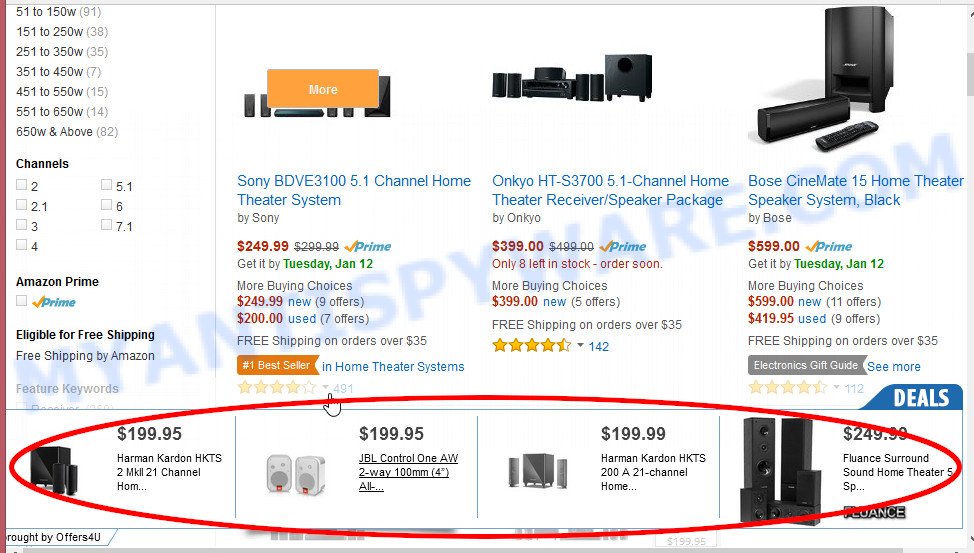
Unwanted ads
Does adware steal your personal information? Adware is able to collect your browsing history and confidential data, including passwords and credit card numbers. In the future, your confidential info can be sold to third party companies. So, we suggest you get rid of SearchKeyWords sooner. This will also prevent the adware from tracking your online activities. A full SearchKeyWords removal can be easily carried out using manual or automatic way listed below.
How does SearchKeyWords get on your MAC OS
Adware is bundled with certain freeware. So always read carefully the setup screens, disclaimers, ‘Terms of Use’ and ‘Software license’ appearing during the install procedure. Additionally pay attention for third-party software that are being installed along with the main application. Ensure that you unchecked all of them! Also, run an adblocker application that will allow to block suspicious and untrustworthy web sites.
Threat Summary
| Name | SearchKeyWords, SearchKeyWords 1.0 app |
| Type | adware, potentially unwanted program (PUP), Mac malware, Mac virus |
| Detection Names | OSX.Trojan.Gen, Trojan-Downloader.OSX.Adload, Adware/Adload!OSX, MacOS.Agent-MT, Program:MacOS/Vigram.A, Osx.Adware.Cimpli, Adware.MAC.Generic and ApplicUnwnt |
| Distribution | Freeware installers, fake updaters, misleading pop-up advertisements and torrent downloads |
| Symptoms | The web-site links redirect to a web sites different from what you expected, pop ups and new tabs are loaded without your request, unwanted program installed without your consent, unwanted web browser toolbars, your web browser search engine has replaced without your permission, low ping but slow Internet. |
| Removal | SearchKeyWords removal guide |
How to remove SearchKeyWords from Mac
We can help you remove SearchKeyWords from your internet browsers, without the need to take your Apple Mac to a professional. Simply follow the removal guide below if you currently have the adware on your MAC and want to get rid of it. If you have any difficulty while trying to remove the SearchKeyWords adware, feel free to ask for our assist in the comment section below. Read this manual carefully, bookmark it or open this page on your smartphone, because you may need to exit your internet browser or reboot your computer.
To remove SearchKeyWords, complete the following steps:
- Remove profiles created by SearchKeyWords
- Delete SearchKeyWords related programs through the Finder
- Remove SearchKeyWords related files and folders
- Scan your Mac with MalwareBytes
- Remove SearchKeyWords from Safari, Chrome, Firefox
- How to stay safe online
Remove profiles created by SearchKeyWords
SearchKeyWords can install a configuration profile on the Mac system to block changes made to the browser settings. Therefore, you need to open system preferences, find and delete the profile installed by the adware software.
Click the System Preferences icon ( ![]() ) in the Dock, or choose Apple menu (
) in the Dock, or choose Apple menu ( ![]() ) > System Preferences.
) > System Preferences.
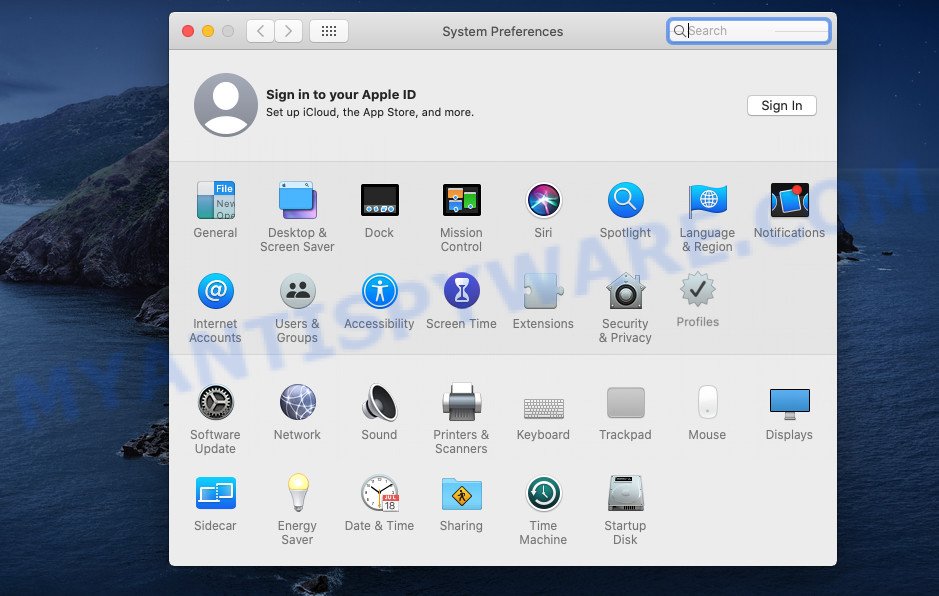
In System Preferences, click Profiles, then select a profile associated with SearchKeyWords.
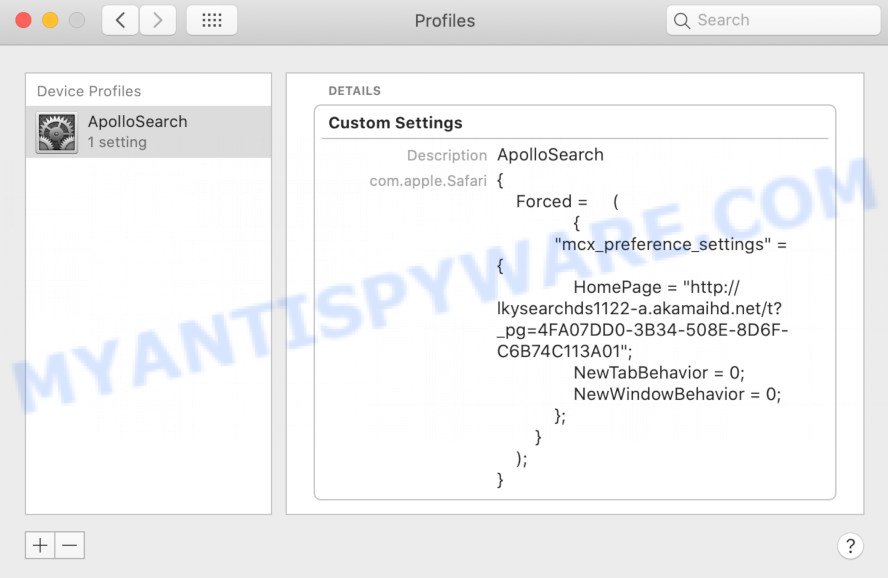
Click the minus button ( – ) located at the bottom-left of the Profiles screen to remove the profile.
Note: if you do not see Profiles in the System Preferences, that means there are no profiles installed on your Mac, which is normal.
Delete SearchKeyWords related programs through the Finder
Check out the Finder (Applications section) to see all installed software. If you see any unknown and suspicious programs, they are the ones you need to remove.
Open Finder and click “Applications”.
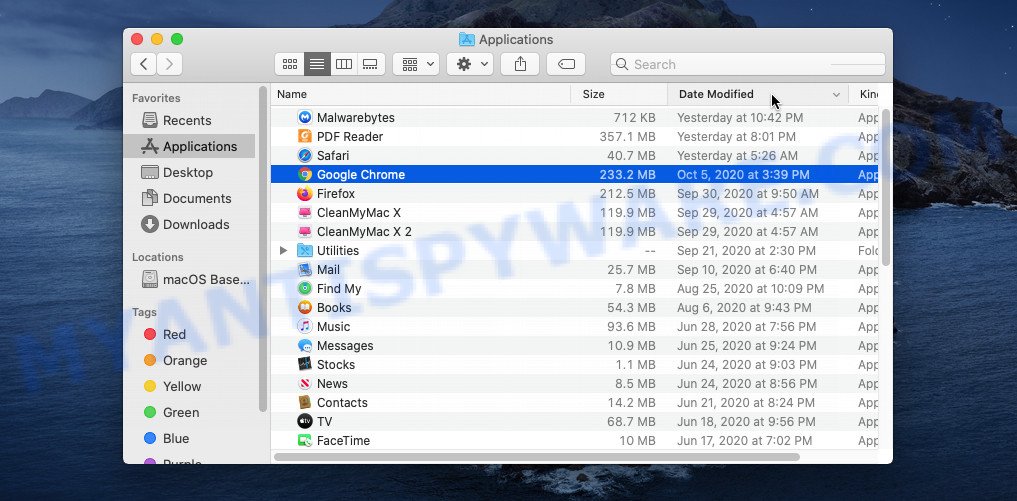
Carefully browse through the list of installed applications and get rid of all questionable and unknown software.
After you’ve found anything questionable that may be the SearchKeyWords adware software or other PUP, then right click this program and choose “Move to Trash”. Once complete, Empty Trash.
Remove SearchKeyWords related files and folders
Now you need to try to find SearchKeyWords related files and folders, and then delete them manually. You need to look for these files in certain directories. To quickly open them, we recommend using the “Go to Folder…” command.
SearchKeyWords creates several files, these files must be found and removed. Below is a list of files associated with this unwanted program.
- /Library/LaunchDaemons/com.SearchKeyWords.system.plist
- ~/Library/LaunchAgents/com.SearchKeyWords.service.plist
- /Library/Application Support/.(RANDOM)/System/com.SearchKeyWords.system
- ~/Library/Application Support/.(RANDOM)/Services/com.SearchKeyWords.service.app
Some files created by SearchKeyWords are hidden from the user. To find and delete them, you need to enable “show hidden files”. To do this, use the shortcut CMD + SHIFT + . Press once to show hidden files and again to hide them. There is another way. Click Finder -> Applications -> Utilities -> Terminal. In Terminal, paste the following text: defaults write com.apple.finder AppleShowAllFiles YES

Press Enter. Hold the ‘Option/alt’ key, then right click on the Finder icon in the dock and click Relaunch.
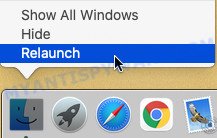
Click on the Finder icon. From the menu bar, select Go and click “Go to Folder…”. As a result, a small window opens that allows you to quickly open a specific directory.

Check for SearchKeyWords generated files in the /Library/LaunchAgents folder

In the “Go to Folder…” window, type the following text and press Go:
/Library/LaunchAgents
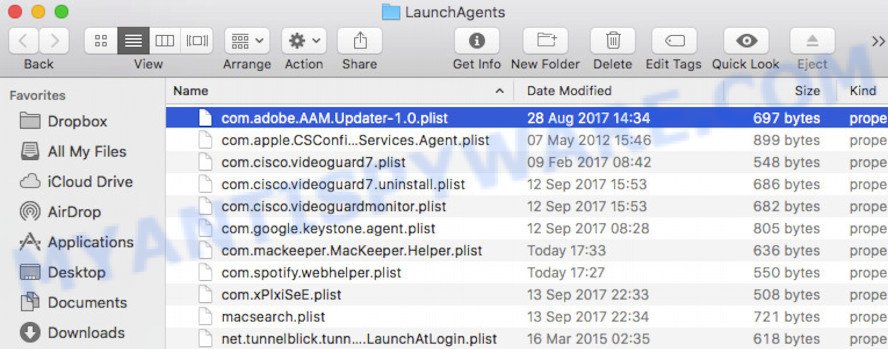
This will open the contents of the “/Library/LaunchAgents” folder. Look carefully at it and pay special attention to recently created files, as well as files that have a suspicious name. Move all suspicious files to the Trash. A few examples of files: search.plist, com.net-preferences.plist, com.google.defaultsearch.plist, , macsearch.plist, com.machelper.plist, installapp.plist and com.SearchKeyWords.service.plist. Most often, browser hijackers, adware software and PUPs create several files with similar names.
Check for SearchKeyWords generated files in the /Library/Application Support folder

In the “Go to Folder…” window, type the following text and press Go:
/Library/Application Support
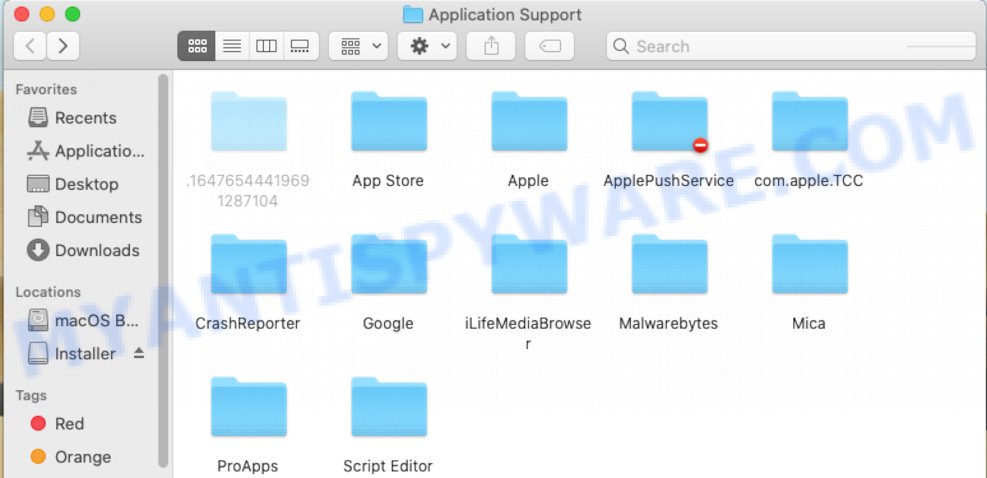
This will open the contents of the “Application Support” folder. Look carefully at its contents, pay special attention to recently added/changed folders and files. Check the contents of suspicious folders, if there is a file with a name similar to com.SearchKeyWords.system, then this folder must be deleted. Move all suspicious folders and files to the Trash.
Check for SearchKeyWords generated files in the “~/Library/LaunchAgents” folder

In the “Go to Folder…” window, type the following text and press Go:
~/Library/LaunchAgents

Proceed in the same way as with the “/Library/LaunchAgents” and “/Library/Application Support” folders. Look for suspicious and recently added files. Move all suspicious files to the Trash.
Check for SearchKeyWords generated files in the /Library/LaunchDaemons folder
In the “Go to Folder…” window, type the following text and press Go:
/Library/LaunchDaemons

Carefully browse the entire list of files and pay special attention to recently created files, as well as files that have a suspicious name. Move all suspicious files to the Trash. A few examples of files to be deleted: com.installapp.system.plist, com.SearchKeyWords.system.plist, com.search.system.plist, com.machelper.system.plist and com.macsearch.system.plist. In most cases, browser hijackers, PUPs and adware create several files with similar names.
Scan your Mac with MalwareBytes
Manual SearchKeyWords removal requires some computer skills. Some files and system entries that created by the adware can be not completely removed. We recommend that run MalwareBytes Free to scan the Mac computer. Moreover, this program will allow you to delete adware, PUPs, toolbars and browser hijackers that your Apple Mac may be affected too.
MalwareBytes Free can be downloaded from the following link.
21018 downloads
Author: Malwarebytes
Category: Security tools
Update: September 10, 2020
Once downloading is finished, close all apps and windows on your Apple Mac. Run the saved file. Follow the prompts.
The MalwareBytes will automatically start and you can see its main screen as shown on the screen below.
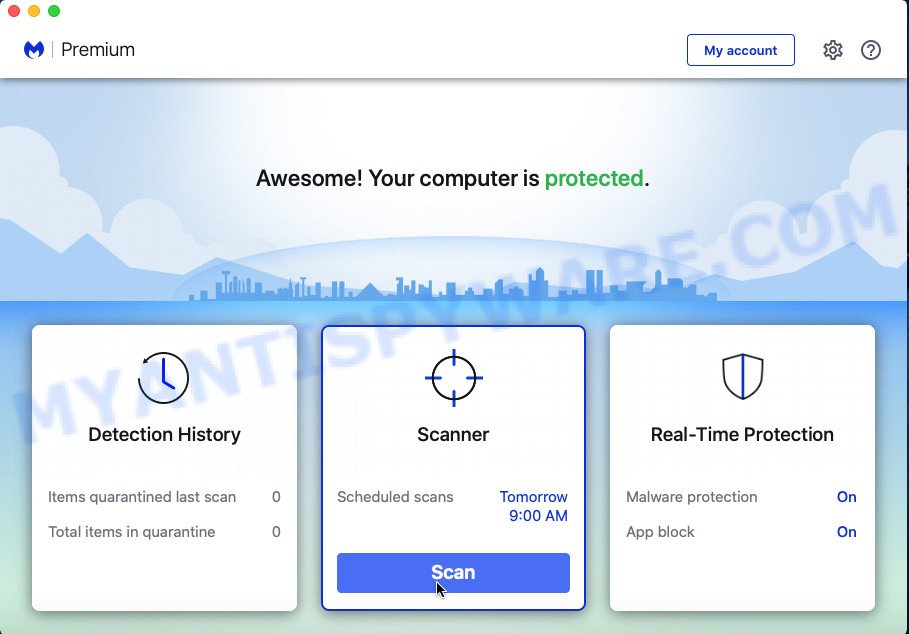
Now click the “Scan” button to begin checking your computer for the SearchKeyWords adware. A scan can take anywhere from 10 to 30 minutes, depending on the number of files on your MAC OS and the speed of your Apple Mac. While the MalwareBytes Anti Malware application is scanning, you can see how many objects it has identified as threat.

Once the scan is complete, MalwareBytes AntiMalware (MBAM) will open a list of all items found by the scan. Once you have selected what you want to delete from your computer click the “Quarantine” button. The MalwareBytes Free will delete SearchKeyWords adware.
Remove SearchKeyWords from Safari, Chrome, Firefox
If you are still getting SearchKeyWords , then you can try to delete it by removing malicious extensions.
You can also try to remove SearchKeyWords by reset Google Chrome settings. |
If you are still experiencing problems with SearchKeyWords removal, you need to reset Firefox browser. |
|
How to stay safe online
We recommend to install an ad-blocking program. The ad-blocker utility like AdGuard is a program which basically removes advertising from the Net and stops access to malicious web pages. Moreover, security experts says that using ad-blocking programs is necessary to stay safe when surfing the Web.
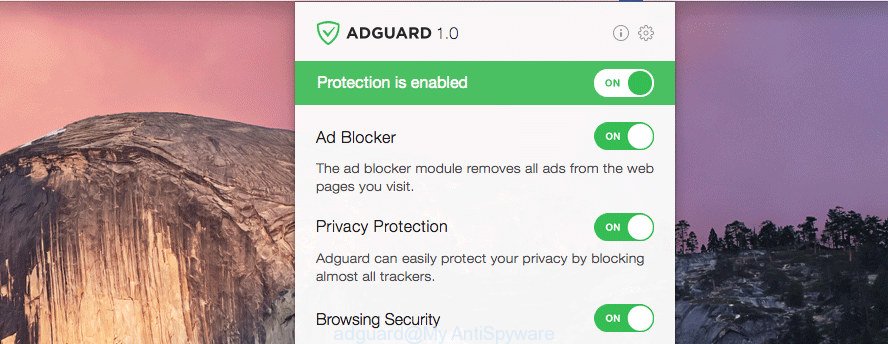
- Visit the page linked below to download the latest version of AdGuard for Mac.
AdGuard for Mac download
3779 downloads
Author: © Adguard
Category: Security tools
Update: January 17, 2018
- Once downloading is done, launch the downloaded file. You will see the “Setup Wizard” program window. Follow the prompts.
- When the installation is done, press “Skip” to close the install program and use the default settings, or click “Get Started” to see an quick tutorial that will allow you get to know AdGuard better.
- In most cases, the default settings are enough and you don’t need to change anything. Each time, when you launch your MAC system, AdGuard will start automatically and stop intrusive ads, block malicious and misleading web sites.
To sum up
Once you’ve done the steps shown above, your computer should be clean from this adware and other malware. The Firefox, Safari and Chrome will no longer display any unwanted ads when you surf the World Wide Web. Unfortunately, if the step-by-step instructions does not help you, then you have caught a new adware, and then the best way – ask for help.
Please create a new question by using the “Ask Question” button in the Questions and Answers. Try to give us some details about your problems, so we can try to help you more accurately. Wait for one of our trained “Security Team” or Site Administrator to provide you with knowledgeable assistance tailored to your problem with the SearchKeyWords adware.

